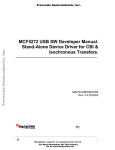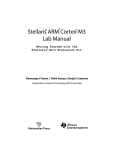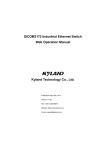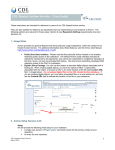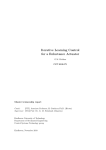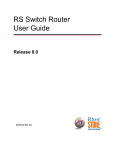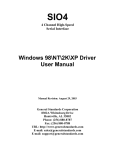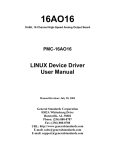Download VxWorks Device Driver User`s Manual
Transcript
..
..
..
..
..
CMI
125 West Park Loop
Huntsville, AL 36806
Phone 256.722.0175
Fax 256.722.0144
Chandler/May, Inc.
.
.
VxWorks Device Driver
User’s Manual
.
.
.
.
.
.
VxWorks Device Driver Software for the
General Standards PMC-16AIO-88
hosted on PowerPC 604 and 80x86
Processors
Document number:
9005003
Revision:
1.1
Date: 03/09/99
Engineering Approval:
Date:
Quality Representative
Approval:
Date:
.
.
PMC-16AIO-88 Driver User’s Manual
Acknowledgments
Copyright 1999, Chandler/May, Inc. (CMI)
ALL RIGHTS RESERVED. The Purchaser of the GSC PMC-16AIO-88 device driver may use or modify in
source form the subject software, but not to re-market it or distribute it to outside agencies or separate
internal company divisions. The software, however, may be embedded in their own distributed software.
In the event the Purchaser's customers require GSC PMC-16AIO-88 device driver source code, then they
would have to purchase their own copy of the GSC PMC-16AIO-88 device driver. CMI makes no warranty,
either expressed or implied, including, but not limited to, any implied warranties of merchantability or fitness
for a particular purpose regarding this software and makes such software available solely on an "as-is"
basis. CMI reserves the right to make changes in the GSC PMC-16AIO-88 device driver design without
reservation and without notification to its users. This document may be copied for the Purchaser's own
internal use but not to re-market it or distribute it to outside agencies or separate internal company
divisions. If this document is to be copied, all copies must be of the entire document and all copyright and
trademark notifications must remain intact. The material in this document is for information only and is
subject to change without notice. While reasonable efforts have been made in the preparation of this
document to assure its accuracy, CMI assumes no liability resulting from errors or omissions in this
document, or from the use of the information contained herein.
CMI, Chandler/May, Inc. logo are trademarks of CMI.
Force is a registered trademark of Force Computers. Inc.
GSC and PMC-16AIO-88 are trademarks of General Standards Corporation
Motorola and the Motorola symbol are registered trademark of Motorola, Inc.
PLX and PLX Technology are trademarks of PLX Technology, Inc.
PowerPC is a trademark of IBM Corporation.
VxWorks and Wind River Systems are registered trademarks of Wind River Systems, Inc.
March 9, 1999
1
PMC-16AIO-88 Driver User’s Manual
1
SCOPE......................................................................................................................................................................3
2
HARDWARE OVERVIEW....................................................................................................................................3
3
REFERENCED DOCUMENTS ..............................................................................................................................4
4
DRIVER INTERFACE............................................................................................................................................4
4.1
GS_16AIODRVINSTALL() .............................................................................................................................. 6
4.2
GS_16AIODRVREMOVE () .............................................................................................................................. 8
4.3
OPEN()............................................................................................................................................................... 9
4.4
CLOSE () ........................................................................................................................................................... 10
4.5
READ()............................................................................................................................................................. 11
4.6
WRITE() .......................................................................................................................................................... 13
4.7
IOCTL() ........................................................................................................................................................... 16
4.7.1
NO_COMMAND..................................................................................................................................18
4.7.2
INIT_BOARD........................................................................................................................................19
4.7.3
READ_REGISTER ...............................................................................................................................20
4.7.4
WRITE_REGISTER..............................................................................................................................25
4.7.5
START_DMA ........................................................................................................................................30
4.7.6
REG_FOR_INT_NOTIFY ...................................................................................................................33
4.7.7
GET_DEVICE_ERROR.......................................................................................................................35
4.7.8
READ_MODE_CONFIG ....................................................................................................................37
4.7.9
INPUT_MODE_CONFIG...................................................................................................................38
4.7.10 INPUT_TEST........................................................................................................................................39
4.7.11 LOOP_TEST_CHANNEL ...................................................................................................................40
4.7.12 CALIBRATION_MODE.......................................................................................................................41
4.7.13 INT_SOURCE.......................................................................................................................................42
4.7.14 ENABLE_PCI_INTERRUPTS............................................................................................................43
4.7.15 DISABLE_PCI_INTERRUPTS...........................................................................................................44
4.7.16 LAST_CHANNEL.................................................................................................................................45
4.7.17 PROGRAM_RATE_GEN ....................................................................................................................46
4.7.18 ENABLE_RATE_GEN.........................................................................................................................47
4.7.19 DISABLE_RATE_GEN........................................................................................................................48
4.7.20 ENABLE_OUTPUT_STROBE............................................................................................................49
4.7.21 DISABLE_OUTPUT_STROBE...........................................................................................................50
4.7.22 CLEAR_INT_REQUEST.....................................................................................................................51
4.7.23 STROBE_OUTPUTS............................................................................................................................52
4.7.24 SCAN_INPUTS ....................................................................................................................................53
March 9, 1999
2
PMC-16AIO-88 Driver User’s Manual
1 Scope
The purpose of this document is to describe how to interface with the PMC-16AIO-88
VxWorks Device Driver developed by Chandler/May, Incorporated (CMI). This software
provides the interface between "Application Software" and the 16AIO-88 Board. The
interface to this board is at the I/O system level. It requires no knowledge of the actual board
addressing of control/data register locations. It does, however, require some knowledge of the
individual bit representations for most control/data registers on the device.
The 16AIO-88 Driver Software executes under control of the VxWorks operating system.
The 16AIO-88 is implemented as a standard VxWorks device driver written in the ‘C’
programming language. The 16AIO-88 Driver Software is designed to operate on CPU
boards containing PowerPC 604 processors as well as VME CPU boards containing 80x86
processors. For example, the Force PPC/PowerCore-6604 CPU Board, the Motorola
MVME 2304, and the SCI JTT 686 CPU board.
2 Hardware Overview
The General Standards Corporation (GSC) 16AIO-88 board is a single-width analog I/O
interface that fits into a PCI Mezzanine Card slot. This board has 16 channels, 8 for input and
8 for output. The output channels are capable of supporting synchronous and asynchronous
modes. The inputs can be customized as 8 single-ended or 4 differential input channels via
software configuration. It also provides for minimum off-line maintenance by providing
calibration and self-testing functions.
The 16AIO-88 board includes a rate generator and a DMA controller. The rate controller is
provided to control the rate input channels are scanned, the output channels are strobed, or
both input and output functions for synchronicity. The DMA transfers are supported when the
board is acting as the bus master and the local bursting mode disabled.
The configuration of the interrupting capability of the 16AIO-88 board is described in the
hardware manual for the board. The 16AIO-88 Device Driver must be used correctly in
accordance with the hardware configuration in order to provide consistent results.
March 9, 1999
3
PMC-16AIO-88 Driver User’s Manual
3 Referenced Documents
The following documents provided reference material used in the development of this design:
•
PMC-16AIO-88 8-Channel, 16-Bit Analog Input/Output User’s Manual – Revision
A, General Standards Corporation.
•
PLX Technology, Inc. PCI 9080 PCI Bus Master Interface Chip data sheet.
•
Motorola MVME2300-Series VME Processor Module Programmer’s Reference
Guide.
•
Force PPC/PowerCore-6603/4 Technical Reference Manual.
4 Driver Interface
The 16AIO-88 Driver conforms to the device driver standards required by the VxWorks
Operating System and contains the following standard driver entry points.
•
GS_16AIODrvInstall() - Installs the device driver for use with multiple 16AIO-88
Cards
•
GS_16AIODrvRemove() - Removes the device driver from use
•
open() - opens a driver interface to one 16AIO-88 Card
•
close() - closes a driver interface to one 16AIO-88 Card
•
read() - reads data received from a 16AIO-88 Card
•
write() - writes data to be transmitted by a 16AIO-88 Card
•
ioctl() - performs various control and setup functions on the 16AIO-88 Card
The 16AIO-88 Device Driver provides a standard I/O system interface to the GSC PMC16AIO-88 card for VxWorks applications which run on the VxWorks target processor. The
device driver is installed and devices created through the use of standard VxWorks I/O system
functions. The functions of the driver can then be used to access the board.
Included in the device driver software package is a menu driven board testing program and
source code. This program is delivered undocumented and unsupported but may be used to
exercise the 16AIO-88 card and device driver. It can also be used to break the learning curve
somewhat for programming the 16AIO-88 device.
March 9, 1999
4
PMC-16AIO-88 Driver User’s Manual
If the user wishes to use the 16AIO Device Driver with the interrupting capability of the board
then a user supplied Interrupt Service Routine (ISR) must be written. This ISR will be called by
the driver when an interrupt is received from the board. There are limitations on the
functionality of a VxWorks ISR. These are documented in the VxWorks Programmer’s Guide
and must be strictly followed in writing the ISR.
The Device Driver initializes the board to disable all types of 16AIO-88 interrupts through
software control except for PCI interrupts controlled through the Shared Runtime - Interrupt
Control/Status register. 16AIO-88 Interrupts must be enabled through the use of the ioctl
function in order to take advantage of the interrupting capability of the board. The ioctl function
must also be used to specify the user supplied ISR which will be invoked when an interrupt is
received from the board. If interrupting is enabled and the user supplied ISR has not been
specified then nothing will happen in the driver when an interrupt is received from the board.
The 16AIO-88 Device Driver allows for multiple boards on a single PCI bus. Each board will
be addressed as a separate VxWorks I/O system device. This device will be created when the
driver is installed and is then available for all driver operations (open, close, ...).
It is important to note that the 16AIO-88 device driver is target processor dependent and thus
BSP dependent. System calls are made within the driver which are only available through
certain board support packages. This is due to the fact that PCI memory and I/O space could
be mapped differently for each target processor board. Also, it may be possible that the PMC
slot interrupt level may be mapped differently for each target processor board.
March 9, 1999
5
PMC-16AIO-88 Driver User’s Manual
4.1
GS_16AIODrvInstall()
The GS_16AIODrvInstall () function installs the device driver into the VxWorks operating
system. This function must be called prior to using any of the other driver functions. This
function should not be called again without first calling the GS_16AIODrvRemove() function.
The GS_16AIODrvInstall () function performs the following operations:
•
Installs the device driver into the VxWorks operating system
•
Performs the following for each PMC Slot on the processor board
•
Determines if this slot contains a PCI card by examining the CPU board’s registers
•
Determines if the slot contains a 16AIO-88 board by examining the PCI
Configuration Device Type and Vendor ID Registers
•
Programs the PCI Configuration Base Address and Configuration Address
Registers with predefined addresses
•
Enables the 16AIO-88 Card to respond over the PCI Bus
•
Connects the driver interrupt handler for the interrupt number
•
Installs a device for the PMC Slot
•
Enables the PCI Interrupt for the PMC Slot
PROTOTYPE:
extern int GS_16AIODrvInstall(BOOL bDebug);
Where:
bDebug - A boolean that is sent to the driver to enable debugging. If enabled the driver will
display error and status messages on the console during driver access. Note, this
should not be enabled during time sensitive processes.
Returns OK on success and ERROR on failure
March 9, 1999
6
PMC-16AIO-88 Driver User’s Manual
EXAMPLE:
STATUS iStatus;
/* Install the 16AIO-88 VxWorks Device Driver. */
iStatus = GS_16AIODrvInstall(TRUE);
March 9, 1999
7
PMC-16AIO-88 Driver User’s Manual
4.2
GS_16AIODrvRemove()
The GS_16AIODrvRemove() function is used to remove the 16AIO-88 Device Driver from
the VxWorks operating system. This function should only be called after a call to the
GS_16AIODrvInstall() function. The GS_16AIODrvRemove() function closes all the open
devices for each PMC slot and removes the device driver from the operating system.
PROTOTYPE:
extern int GS_16AIODrvRemove(void);
Returns OK on success and ERROR on failure
EXAMPLE:
STATUS iStatus;
/* Remove the 16AIO-88 Driver */
iStatus = GS_16AIODrvRemove();
March 9, 1999
8
PMC-16AIO-88 Driver User’s Manual
4.3
open()
The open() function is the standard VxWorks entry point to open a connection to a 16AIO-88
Card in one PMC Slot. This function may only be called after a call to the
GS_16AIODrvInstall() function is made.
PROTOTYPE:
extern int open(const char *cName, int iFlags, int iMode)
Where:
cName -
name of the device being opened which is one of the following depending on the
slot the 16AIO-88 Board is in:
•
GS_16AIO_PMC1
•
GS_16AIO_PMC2
iFlags -
is not used.
iMode -
is not used.
Returns OK on success and ERROR on failure
EXAMPLE:
int
LOCAL char
int
FileDesc[2];
*slotName[] = { GS_16AIO_PMC1, GS_16AIO_PMC2};
16AIOSlot = 1;
/*
open the 16AIO-88 device for slot 1
*/
FileDesc[16AIOSlot] = open(slotName[16AIOSlot], O_RDWR, 0644);
if (FileDesc[16AIOSlot] == ERROR)
{
logMsg("Cannot Open Device Error %s\n\n",
(int) slotName[16AIOSlot], 0, 0, 0, 0, 0);
}
March 9, 1999
9
PMC-16AIO-88 Driver User’s Manual
4.4
close()
The close() function is the standard VxWorks entry point to close a connection to a 16AIO-88
Card in one PMC Slot. This function should only be called after the open function has been
successfully called for a slot where a 16AIO-88 Card resides. The close function closes an
interface to a 16AIO-88 device.
PROTOTYPE:
extern STATUS close(int iFd);
Where:
iFd -
File Descriptor returned from a call to the open function.
Returns OK if successful or ERROR if unsuccessful.
EXAMPLE:
int FileDesc[2];
int 16AIOSlot = 1;
/*
if
{
close the device on slot 2 */
(close(FileDesc[16AIOSlot]) == ERROR)
logMsg("Close Error for Slot #%d\n\n", 16AIOSlot, 0, 0, 0, 0, 0);
}
FileDesc[16AIOSlot] = ERROR;
March 9, 1999
10
PMC-16AIO-88 Driver User’s Manual
4.5
read()
The read() function is the standard VxWorks entry point to receive channel data from a
16AIO-88 Card FIFO in one PMC Slot. This function should only be called after the open
function has been successfully called for a slot where a 16AIO-88 Card resides. The 16AIO88 has two data configurations in which the input channels can be read, single-ended and
differential. In the single-ended mode, there are 8 input channels read as 2 bytes each channel.
Whereas in differential mode, there are only 4 input channels also with 2 bytes read each
channel. Depending on the read mode of the driver which can be set using the ioctl() function,
the FIFO data will either be transferred to the user buffer using the PLX 9080 DMA capability
or will be accessed directly and assigned 16 bits at a time. Regardless of configuration, the
read() function will read these channels in sequential order starting with channel 0. Each
channel is capable of handling 16 bits of data.
The read() logic is as follows:
•
Verify pointer to user buffer and note the requested number of bytes to read.
•
Take the semaphore.
•
Check analog input mode selection – is it single ended or differential.
•
Calculate the number of input scans requested based on the requested number of bytes
and the analog input mode.
•
Verify that the number of input scans requested is greater than zero.
•
If the driver is in DMA_MODE then first verify the number of scans available in the
input FIFO buffer is not less than the number of scans requested. If it is less that what
is requested then adjust the number of scans requested to match what is available.
Next setup and transfer data to the user buffer from the input FIFO.
•
If the driver is in the SCAN_MODE then burst the inputs if necessary, verify the
number of samples in the input FIFO buffer, then read each channel one at a time.
Repeat this process based on the number of scans requested.
•
Return the number of bytes read.
March 9, 1999
11
PMC-16AIO-88 Driver User’s Manual
PROTOTYPE:
extern int read(int iFd, char *cBuffer, size_t iMaxbytes);
Where:
iFd -
File Descriptor returned from a call to the open function.
CBuffer -
pointer to character array to store read bytes.
iMaxbytes -
maximum number of bytes to read.
Returns Number of bytes read if successful or ERROR if unsuccessful.
EXAMPLE:
#define MAXSAMPLES 8
int
int
int
char
FileDesc[2];
iNumBytesRead;
16AIOSlot = 1;
pusBuffer[MAXSAMPLES * 2];
/* Configure driver read() mode */
if( ioctl( FileDesc[16AIOSlot], READ_MODE_CONFIG, DMA_MODE) == ERROR )
{
logMsg("ioctl READ_MODE_CONFIG Failed for Slot #%d\n\n",
16AIOSlot, 0, 0, 0, 0, 0);
}
/* Configure Input Channel Mode */
if( ioctl( FileDesc[16AIOSlot], INPUT_MODE_CONFIG, SINGLE_CONTINUOUS )
== ERROR )
{
logMsg("ioctl INPUT_MODE_CONFIG Failed for Slot #%d\n\n",
16AIOSlot, 0, 0, 0, 0, 0);
}
/* Read from the 16AIO-88 device */
iNumBytesRead = read(FileDesc[16AIOSlot],
pusBuffer,
sizeof(pusBuffer));
if (iNumBytesRead == 0)
{
logMsg("Read failed for Slot #%d\n", 16AIOSlot, 0, 0, 0, 0, 0);
}
March 9, 1999
12
PMC-16AIO-88 Driver User’s Manual
4.6
write()
The write() function is the standard VxWorks entry point to transmit channel data to the
16AIO-88 Card FIFO in one PMC Slot. This function should only be called after the open
function has been successfully called for a slot where a 16AIO-88 Card resides. For the
PMC-16AIO-88 it is necessary for the data to be in a 16-bit format. The data written to the
output channels should have the channel number first followed by the data. Therefore, there is
a structure provided specifically for this purpose. It is in the header file of the driver. It should
be noted that it is the user’s responsibility to strobe the outputs after using the write() function if
the automatic updating of outputs has been disabled. The data written to the output buffer must
be flushed to the output channel specified by the user. Thus, an output strobe is necessary. This
is done to give the user flexibility for writing one or many channels at a time.
The write() logic is as follows:
•
Verify pointer to user buffer and note the requested number of bytes to write.
•
Take the semaphore.
•
Calculate the number of output samples based on the requested number of bytes.
•
Validate the channel number for the sample to be written. Verify that there is room in
the output buffer for the current channel number to be written. Write the channel
number to the output FIFO. Verify that there is room in the output buffer for the
current sample to be written. Write the sample to the output FIFO. Repeat this process
based on the number of samples given.
•
Return the number of bytes written.
PROTOTYPE:
extern int write(int iFd, char *cBuffer, size_t iNBytes);
Where:
iFd -
File Descriptor returned from a call to the open function.
cBuffer -
pointer to WRITE_PARAM structure containing an array of channel data and
sample data to write.
iNBytes - total number of bytes to write.
Returns Number of bytes written if successful or ERROR if unsuccessful. This includes 16 bits
of channel information as well as 16 bits of channel data for each sample.
March 9, 1999
13
PMC-16AIO-88 Driver User’s Manual
typedef struct WriteParam
{
USHORT usChannel;
USHORT usData;
} WRITE_PARAM;
EXAMPLE:
int
int
WRITE_PARAM
int
FileDesc[2];
i, iNumBytesWritten;
pusBuffer[8];
16AIOSlot = 1;
for ( i = 0; i < 8; i++ )
{
pusBuffer[i].usChannel = (USHORT)i;
pusBuffer[i].usData = 0xAAAA;
}
/* Disable Automatic Output Strobe. */
if (ioctl(FileDesc[16AIOSlot], DISABLE_OUTPUT_STROBE, 0) == ERROR)
{
logMsg("Disable Output Strobe Failed for Slot #%d\n\n",
16AIOSlot, 0, 0, 0, 0, 0 );
}
iNumBytesWritten = write(FileDesc[16AIOSlot],
(char*)&pusBuffer,
sizeof(pusBuffer));
if (iNumBytesWritten == 0)
{
logMsg("write failed for Slot #%d\n", 16AIOSlot, 0, 0, 0, 0, 0);
}
else
{
if (iNumBytesWritten != (8*sizeof(WRITE_PARAM)))
{
logMsg("Only wrote %d bytes\n",
iNumBytesWritten, 0, 0, 0, 0, 0);
}
else
{
/* Strobe Outputs. */
if (ioctl(FileDesc[16AIOSlot], STROBE_OUTPUTS, 0) == ERROR)
{
March 9, 1999
14
PMC-16AIO-88 Driver User’s Manual
logMsg("Output Strobe Failed for Slot #%d\n\n",
16AIOSlot, 0, 0, 0, 0, 0 );
}
}
}
March 9, 1999
15
PMC-16AIO-88 Driver User’s Manual
4.7
ioctl()
The ioctl() function is the standard VxWorks entry point to perform control and setup
operations on an 16AIO-88 Card in one PMC Slot. This function should only be called after
the open function has been successfully called for a slot where a 16AIO-88 Card resides. The
ioctl() function will perform different functions based upon the function parameter. These
functions will be described in the following subparagraphs.
PROTOTYPE:
extern int ioctl(int iFd, int iFunction, int iArg);
Where:
iFd - File Descriptor returned from a call to the open function.
iFunction - The ioctl function to perform which is one of the following:
NO_COMMAND - Empty Command, performs nothing.
INIT_BOARD - Initializes the 16AIO-88 Board.
READ_REGISTER - Reads a specified 16AIO-88 Register.
WRITE_REGISTER - Writes to a specified 16AIO-88 Register.
START_DMA - Starts a DMA Read from the 16AIO Board
REG_FOR_INT_NOTIFY - Registers the application code to be Notified when an
Interrupt occurs.
GET_DEVICE_ERROR - Returns the Error that occurred during the last access to the
16AIO-88 Driver.
READ_MODE_CONFIG - Configures the 16AIO-88 read() mode (FIFO scan reads
or DMA enabled FIFO reads).
INPUT_MODE_CONFIG - Configures the 16AIO-88 Input channels (single-ended or
differential mode, burst or continuous scan).
INPUT_TEST – Performs a Self-test for 16AIO-88 Board validation.
LOOP_TEST_CHANNEL – Sets the output Channel to be connected to input channel 0
for Loopback Test.
CALIBRATION_MODE – Sets and runs Calibration operation.
March 9, 1999
16
PMC-16AIO-88 Driver User’s Manual
INT_SOURCE – Sets Interrupt Source condition.
ENABLE_PCI_INTERRUPTS – Enables PCI Interrupts in order for the 16AIO-88 to
produce a local interrupt request.
DISABLE_PCI_INTERRUPTS – Disables PCI Interrupts.
LAST_CHANNEL – Sets the Last output Channel in strobe sequence.
PROGRAM_RATE_GEN – Programs the Rate Generator for specified rate frequency.
ENABLE_RATE_GEN – Enables and Configures the Rate Generator to control the
input scan rate, the output strobe rate, or both.
DISABLE_RATE_GEN – Disables the Rate Generator for preferred rate (input, output,
or both).
ENABLE_OUTPUT_STROBE – Enables the Output Strobe and disables automatic
updating of outputs.
DISABLE_OUTPUT_STOBE – Disables the Output Strobe and enable automatic
updating of outputs.
CLEAR_INT_REQUEST – Clears the Interrupt Request flag.
STROBE_OUTPUTS – Strobes all Output channels once.
SCAN_INPUTS – Scans all Input channels once.
iArg - The parameters to the specific ioctl() function. See the following subsections for a
description of the parameters for each function.
Returns OK if successful or ERROR if unsuccessful.
March 9, 1999
17
PMC-16AIO-88 Driver User’s Manual
4.7.1
NO_COMMAND
This is an empty driver entry point. This command may be given to validate that the driver
is correctly installed and that the 16AIO-88 Board Device has been successfully opened.
arg PARAMETER:
Not used.
EXAMPLE:
int FileDesc[2];
int 16IAOSlot = 1;
if (ioctl(FileDesc[16AIOSlot], NO_COMMAND, 0) == ERROR)
{
logMsg("ioctl NO_COMMAND Failed for Slot #%d\n\n", 16AIOSlot,
0, 0, 0, 0, 0);
}
March 9, 1999
18
PMC-16AIO-88 Driver User’s Manual
4.7.2
INIT_BOARD
The INIT_BOARD Function initializes the board and sets all defaults.
arg PARAMETER:
Not used.
EXAMPLE:
int FileDesc[2];
int 16AIOSlot = 1;
if (ioctl(FileDesc[16AIOSlot], INIT_BOARD, 0) == ERROR)
{
logMsg("Board Initialization Failed for Slot #%d\n\n", 16AIOSlot,
0, 0, 0, 0, 0);
}
March 9, 1999
19
PMC-16AIO-88 Driver User’s Manual
4.7.3
READ_REGISTER
The READ_REGISTER Function reads and returns the contents of one of the 16IAO-88
Registers.
arg PARAMETER:
REG_PARAM *
int e16AIORegister - One of the following registers to read. Refer to the 16AIO-88
Hardware documentation for a description of each register.
*** 16AIO-88 Registers ***
BOARD_CTRL_REG
RATE_GEN_REG
IN_OUT_FIFO_REG
RATE_CTRL_REG
INPUT_BUF_PTR_REG
BUFFER_FLAGS_REG
*** DMA Registers ***
DMA_CH_0_MODE
DMA_CH_0_PCI_ADDR
DMA_CH_0_LOCAL_ADDR
DMA_CH_0_TRANS_BYTE_CNT
DMA_CH_0_DESC_PTR
DMA_CH_1_MODE
DMA_CH_1_PCI_ADDR
DMA_CH_1_LOCAL_ADDR
March 9, 1999
20
PMC-16AIO-88 Driver User’s Manual
DMA_CH_1_TRANS_BYTE_CNT
DMA_CH_1_DESC_PTR
DMA_CMD_STATUS
DMA_MODE_ARB_REG
DMA_THRESHOLD_REG
*** PCI Configuration Registers ***
DEVICE_VENDOR_ID
STATUS_COMMAND
CLASS_CODE_REVISION_ID
BIST_HDR_TYPE_LAT_CACHE_SIZE
PCI_MEM_BASE_ADDR
PCI_IO_BASE_ADDR
PCI_BASE_ADDR_0
PCI_BASE_ADDR_1
CARDBUS_CIS_PTR
SUBSYS_ID_VENDOR_ID
PCI_BASE_ADDR_LOC_ROM
LAT_GNT_INT_PIN_LINE
*** Local Configuration Registers. ***
PCI_TO_LOC_ADDR_0_RNG
LOC_BASE_ADDR_REMAP_0
MODE_ARBITRATION
BIG_LITTLE_ENDIAN_DESC
March 9, 1999
21
PMC-16AIO-88 Driver User’s Manual
PCI_TO_LOC_ROM_RNG
LOC_BASE_ADDR_REMAP_EXP_ROM
BUS_REG_DESC_0_FOR_PCI_LOC
DIR_MASTER_TO_PCI_RNG
LOC_ADDR_FOR_DIR_MASTER_MEM
LOC_ADDR_FOR_DIR_MASTER_IO
PCI_ADDR_REMAP_DIR_MASTER
PCI_CFG_ADDR_DIR_MASTER_IO
PCI_TO_LOC_ADDR_1_RNG
LOC_BASE_ADDR_REMAP_1
BUS_REG_DESC_1_FOR_PCI_LOC
*** Run Time Registers ***
MAILBOX_REGISTER_0
MAILBOX_REGISTER_1
MAILBOX_REGISTER_2
MAILBOX_REGISTER_3
MAILBOX_REGISTER_4
MAILBOX_REGISTER_5
MAILBOX_REGISTER_6
MAILBOX_REGISTER_7
PCI_TO_LOC_DOORBELL
LOC_TO_PCI_DOORBELL
INT_CTRL_STATUS
PROM_CTRL_CMD_CODES_CTRL
March 9, 1999
22
PMC-16AIO-88 Driver User’s Manual
DEVICE_ID_VENDOR_ID
REVISION_ID
MAILBOX_REG_0
MAILBOX_REG_1
*** Messaging Queue Registers ***
OUT_POST_Q_INT_STATUS
OUT_POST_Q_INT_MASK
IN_Q_PORT
OUT_Q_PORT
MSG_UNIT_CONFIG
Q_BASE_ADDR
IN_FREE_HEAD_PTR
IN_FREE_TAIL_PTR
IN_POST_HEAD_PTR
IN_POST_TAIL_PTR
OUT_FREE_HEAD_PTR
OUT_FREE_TAIL_PTR
OUT_POST_HEAD_PTR
OUT_POST_TAIL_PTR
Q_STATUS_CTRL_REG
ULONG *pulValue - Pointer to the location where the value read is to be stored
EXAMPLE:
March 9, 1999
23
PMC-16AIO-88 Driver User’s Manual
int
REG_PARAM
ULONG
int
FileDesc[2];
theReg;
ulValue;
16AIOSlot = 1;
theReg.pulValue = &ulValue;
theReg.e16AIORegister = BOARD_CTRL_REG;
if (ioctl(FileDesc[16AIOSlot], READ_REGISTER, (int) &theReg) ==
ERROR)
{
logMsg("Read Register Failed for Slot #%d\n\n", 16AIOSlot,
0, 0, 0, 0, 0);
}
March 9, 1999
24
PMC-16AIO-88 Driver User’s Manual
4.7.4
WRITE_REGISTER
The WRITE_REGISTER Function writes a value to one of the 16AIO-88 Registers.
arg PARAMETER:
REG_PARAM *
int e16AIORegister - One of the following registers to write. Refer to the 16AIO-88
Hardware documentation for a description of each register.
*** 16AIO-88 Registers ***
BOARD_CTRL_REG
RATE_GEN_REG
IN_OUT_FIFO_REG
RATE_CTRL_REG
*** DMA Registers ***
DMA_CH_0_MODE
DMA_CH_0_PCI_ADDR
DMA_CH_0_LOCAL_ADDR
DMA_CH_0_TRANS_BYTE_CNT
DMA_CH_0_DESC_PTR
DMA_CH_1_MODE
DMA_CH_1_PCI_ADDR
DMA_CH_1_LOCAL_ADDR
DMA_CH_1_TRANS_BYTE_CNT
DMA_CH_1_DESC_PTR
March 9, 1999
25
PMC-16AIO-88 Driver User’s Manual
DMA_CMD_STATUS
DMA_MODE_ARB_REG
DMA_THRESHOLD_REG
*** PCI Configuration Registers ***
DEVICE_VENDOR_ID
STATUS_COMMAND
CLASS_CODE_REVISION_ID
BIST_HDR_TYPE_LAT_CACHE_SIZE
PCI_MEM_BASE_ADDR
PCI_IO_BASE_ADDR
PCI_BASE_ADDR_0
PCI_BASE_ADDR_1
CARDBUS_CIS_PTR
SUBSYS_ID_VENDOR_ID
PCI_BASE_ADDR_LOC_ROM
LAT_GNT_INT_PIN_LINE
*** Local Configuration Registers. ***
PCI_TO_LOC_ADDR_0_RNG
LOC_BASE_ADDR_REMAP_0
MODE_ARBITRATION
BIG_LITTLE_ENDIAN_DESC
PCI_TO_LOC_ROM_RNG
LOC_BASE_ADDR_REMAP_EXP_ROM
March 9, 1999
26
PMC-16AIO-88 Driver User’s Manual
BUS_REG_DESC_0_FOR_PCI_LOC
DIR_MASTER_TO_PCI_RNG
LOC_ADDR_FOR_DIR_MASTER_MEM
LOC_ADDR_FOR_DIR_MASTER_IO
PCI_ADDR_REMAP_DIR_MASTER
PCI_CFG_ADDR_DIR_MASTER_IO
PCI_TO_LOC_ADDR_1_RNG
LOC_BASE_ADDR_REMAP_1
BUS_REG_DESC_1_FOR_PCI_LOC
*** Run Time Registers ***
MAILBOX_REGISTER_0
MAILBOX_REGISTER_1
MAILBOX_REGISTER_2
MAILBOX_REGISTER_3
MAILBOX_REGISTER_4
MAILBOX_REGISTER_5
MAILBOX_REGISTER_6
MAILBOX_REGISTER_7
PCI_TO_LOC_DOORBELL
LOC_TO_PCI_DOORBELL
INT_CTRL_STATUS
PROM_CTRL_CMD_CODES_CTRL
DEVICE_ID_VENDOR_ID
REVISION_ID
March 9, 1999
27
PMC-16AIO-88 Driver User’s Manual
MAILBOX_REG_0
MAILBOX_REG_1
*** Messaging Queue Registers ***
OUT_POST_Q_INT_STATUS
OUT_POST_Q_INT_MASK
IN_Q_PORT
OUT_Q_PORT
MSG_UNIT_CONFIG
Q_BASE_ADDR
IN_FREE_HEAD_PTR
IN_FREE_TAIL_PTR
IN_POST_HEAD_PTR
IN_POST_TAIL_PTR
OUT_FREE_HEAD_PTR
OUT_FREE_TAIL_PTR
OUT_POST_HEAD_PTR
OUT_POST_TAIL_PTR
Q_STATUS_CTRL_REG
ULONG *pulValue - Pointer to the location containing the value to be written.
EXAMPLE:
int
FileDesc[2];
REG_ PARAM theReg;
ULONG ulValue = 0xAAAA;
March 9, 1999
28
PMC-16AIO-88 Driver User’s Manual
int
16AIOSlot = 1;
theReg.pulValue = &ulValue;
theReg.e16AIORegister = OUT_Q_PORT;
if (ioctl(FileDesc[16AIOSlot], WRITE_REGISTER, (int) &theReg) ==
ERROR)
{
logMsg("Write Register Failed for Slot #%d\n\n", 16AIOSlot,
0, 0, 0, 0, 0);
}
March 9, 1999
29
PMC-16AIO-88 Driver User’s Manual
4.7.5
START_DMA
The START_DMA function configures the 16AIO-88 DMA Registers for a DMA
Transfer from the board, and then starts the transfer.
arg PARAMETER:
DMA_PARAM *
int DMAChannel - DMA Channel to perform transfer on. Must be one of the following:
•
DMA_CHAN_0
•
DMA_CHAN_1
ULONG ulDMAMode - Value to be written to the 16AIO-88 DMA Mode Register.
ULONG ulDMALocalAddress - Value to be written to the 16AIO-88 DMA Local
Address Register. Data returned is little endian and
may need to be byte/word swapped.
ULONG ulDMAByteCount - Value to be written to the 16AIO-88 DMA Byte Count
Register.
ULONG ulDMADescriptorPtr - Value to be written to the 16AIO-88 DMA Descriptor
Pointer Register.
ULONG ulDMAArbitration - Value to be written to the 16AIO-88 DMA Arbitration
Register.
ULONG ulDMAThreshold - Value to be written to the 16AIO-88 DMA Threshold
Register.
See the PLX-PCI PCI Bus Master Interface Data Sheet for a description of the DMA
Registers.
March 9, 1999
30
PMC-16AIO-88 Driver User’s Manual
DMA READ EXAMPLE:
#define
int
DMA_PARAM
ULONG
REG_PARAM
ULONG
DWORD_COUNT 80
iIndex, FileDesc[2], 16AIOSlot = 1;
DMAParameters;
pulBuffer[DWORD_COUNT];
theReg;
ulValue;
/* Scan input channels.
*/
if(ioctl(FileDesc[16AIOSlot], SCAN_INPUTS, 0) == ERROR)
{
logMsg("Input Scan Failed\n\n", 0, 0, 0, 0, 0, 0);
}
/* Setup parameters to perform a
*/
DMAParameters.DMAChannel
DMAParameters.ulDMAMode
DMAParameters.ulDMALocalAddress
DMAParameters.ulDMAByteCount
DMAParameters.ulDMADescriptorPtr
DMAParameters.ulDMAArbitration
DMAParameters.ulDMAThreshold
DMA Read from the 16AIO-88 Board.
=
=
=
=
=
=
=
0;
0x943;
(ULONG) pulBuffer;
DWORD_COUNT * 4;
0xA;
0;
0;
if (ioctl(FileDesc[16AIOSlot], START_DMA, (int) &DMAParameters) ==
ERROR)
{
logMsg("Start DMA Failed for Slot #%d\n\n", 16AIOSlot,
0, 0, 0, 0, 0);
}
/* Wait for the DMA to Complete. */
theReg.pulValue
= &ulValue;
theReg.e16AIORegister
= DMA_CMD_STATUS;
do
{
if (ioctl(FileDesc[16AIOSlot], READ_REGISTER, (int) &theReg) ==
ERROR)
{
logMsg("Read Register Failed for Slot #%d\n\n", 16AIOSlot,
0, 0, 0, 0, 0);
break;
}
} while (! (ulValue & 0x10));
/* Clear the DMA channel 0/1 command/status register.
*/
ulValue = 0;
theReg.pulValue
= &ulValue;
theReg.e16AIORegister = DMA_CMD_STATUS;
March 9, 1999
31
PMC-16AIO-88 Driver User’s Manual
if (ioctl(FileDesc[16AIOSlot], WRITE_REGISTER, (int) &theReg) ==
ERROR)
{
logMsg("Write Register Failed\n\n",
0, 0, 0, 0, 0, 0);
}
March 9, 1999
32
PMC-16AIO-88 Driver User’s Manual
4.7.6
REG_FOR_INT_NOTIFY
The REG_FOR_INT_NOTIFY function will register or unregister for notification that an
interrupt has occurred on the 16AIO-88 Board. If this function is called with a pointer to a
subroutine, that routine will be invoked when a 16AIO-88 Interrupt occurs. If a function is
currently registered for interrupt notification and this function is called with a NULL pointer,
the function will no longer be called when an interrupt occurs. The parameter sent to the
notification routine will be the slot number of the 16AIO-88 Board that has interrupted and
will be one of the following:
•
16AIO_PMC1
•
16AIO_PMC2
Note that the internal driver interrupt handler will clear interrupts after calling the user
supplied ISR.
arg PARAMETER:
int (*intHandler)(int) - Pointer to a routine to handle the interrupt notification or a NULL
Pointer if the caller wants to unregister for interrupt notification.
EXAMPLE:
int FileDesc[2];
int 16AIOSlot = 1;
int intHandler(ULONG ulSlotNum)
{
REG_PARAM
theReg;
ULONG
ulValue;
/* execute interrupt control here */
return (0);
}
/* intHandler */
/* Request notification on the user selected conditions. */
if (ioctl(FileDesc[16AIOSlot], REG_FOR_INT_NOTIFY, (int) intHandler)
== ERROR)
{
March 9, 1999
33
PMC-16AIO-88 Driver User’s Manual
logMsg("Request Interrupt Notification Failed\n\n",0,0,0,0,0,0 );
}
March 9, 1999
34
PMC-16AIO-88 Driver User’s Manual
4.7.7
GET_DEVICE_ERROR
The GET_DEVICE_ERROR function will return the error that occurred on the last call to
one of the 16AIO-88 Device Driver entry points. Whenever a driver function is called and
it returns an error, this function may be called to determine the cause of the error.
arg PARAMETER:
int * - Pointer to the location of where the error code is to be written. It will be one of the
following:
NO_ERR - No Error Occurred.
INVALID_PARAMETER_ERR - An Invalid Parameter was sent to driver.
RESOURCE_ERR - The driver could not obtain a resource (memory or semaphore) to
perform its function.
BOARD_ACCESS_ERR - Failure occurred when the GS_16AIODrvInstall function
fails when probing the 16AIO-88 card’s Board Status
Register.
DEVICE_ADD_ERROR - Failure occurred when the GS_16AIODrvInstall function
fails when trying to add device to the VxWorks Operating
System.
ALREADY_OPEN_ERROR - A call to the open driver access routine for a device that
is already open.
INVALID_DRV_NUM_ERR - Returned from the GS_16AIODrvInstall function if an
invalid driver number was obtained when trying to add
the device driver to the VxWorks operating system.
Also returned from the GS_16AIODrvRemove
function if the driver failed to remove the device driver
from the VxWorks operating system.
ALREADY_INSTALLED_ERR - Returned from the GS_16AIODrvInstall function if
the driver has already been installed.
PCI_CONFIG_ERR - Returned from the GS_16AIODrvInstall function if a read or
write of a PCI Configuration Register fails.
March 9, 1999
35
PMC-16AIO-88 Driver User’s Manual
INVALID_BOARD_STATUS_ERR - Returned from the GS_16AIODrvInstall
function if an invalid board status is read from
the 16AIO-88 Board.
FIFO_BUFFER_ERR - If during a write() transaction the FIFO buffer is indicated to be
full by the status of the buffer status register, the driver will
return the number of bytes that could be written along with
throwing this error condition.
EXAMPLE:
int FileDesc[2];
int 16AIOSlot = 1;
int Status;
/* Send the Get Device Error Code Command for this channel
*/
if (ioctl(FileDesc[16AIOSlot], GET_DEVICE_ERROR, (int) &Status) ==
ERROR)
{
logMsg("Get Device Error Code Failed for Slot #%d\n\n",
16AIOSlot, 0, 0, 0, 0, 0);
}
March 9, 1999
36
PMC-16AIO-88 Driver User’s Manual
4.7.8
READ_MODE_CONFIG
The READ_MODE_CONFIG function will configure the driver for the type of read() from
the input FIFO to be performed. There are two types of reads. The first being referred to
as SCAN_MODE where each sample is read out of the input FIFO one at a time and put
into the user buffer given. The other type of read is referred to as DMA_MODE where the
DMA capability of the board is taken advantage of.
arg PARAMETER:
int * - Pointer to one of the following values:
•
SCAN_MODE
•
DMA_MODE
EXAMPLE:
int FileDesc[2];
int 16AIOSlot = 1;
int iMode;
iMode = DMA_MODE;
if (ioctl(FileDesc[16AIOSlot], READ_MODE_CONFIG, (int) &iMode) ==
ERROR)
{
logMsg("Read Mode Configuration Failed for Slot #%d\n\n",
16AIOSlot, 0, 0, 0, 0, 0);
}
March 9, 1999
37
PMC-16AIO-88 Driver User’s Manual
4.7.9
INPUT_MODE_CONFIG
The INPUT_MODE_CONFIG function will arrange input channels into single-ended or
differential mode, and set either burst or continuous scan.
arg PARAMETER:
int * - Pointer to one of the following values:
•
SINGLE_CONTINUOUS
•
SINGLE_BURST
•
DIFF_CONTINUOUS
•
DIFF_BURST
EXAMPLE:
int FileDesc[2];
int 16AIOSlot = 1;
int iMode;
iMode = DIFF_BURST;
if (ioctl(FileDesc[16AIOSlot], INPUT_MODE_CONFIG, (int) &iMode) ==
ERROR)
{
logMsg("Input Configuration Failed for Slot #%d\n\n", 16AIOSlot,
0, 0, 0, 0, 0);
}
March 9, 1999
38
PMC-16AIO-88 Driver User’s Manual
4.7.10 INPUT_TEST
The INPUT_TEST function will perform a system level validation of operation precision.
There are several tests, such as a loopback test, positive reference test, and zero input test.
During the loopback test, one output channel is connected to the input channel 0. During
the positive reference test, an internal voltage reference is connected to all input channels.
The zero input test consists of all input channels being connected to the internal ground.
arg PARAMETER:
int * - Pointer to one of the following values:
•
LOOPBACK
•
POSITIVE_REF
•
ZERO
EXAMPLE:
int FileDesc[2];
int 16AIOSlot = 1;
int Test;
Test = ZERO;
if (ioctl(FileDesc[16AIOSlot], INPUT_TEST, (int) &Test) == ERROR)
{
logMsg("Input Test Failed for Slot #%d\n\n", 16AIOSlot,
0, 0, 0, 0, 0);
}
March 9, 1999
39
PMC-16AIO-88 Driver User’s Manual
4.7.11 LOOP_TEST_CHANNEL
The LOOP_TEST_CHANNEL function will set the output channel to be tested in the
loopback selftest. This must take place before the loopback test is started.
arg PARAMETER:
int * - Pointer to one of the following values:
•
CHANNEL0
•
CHANNEL1
•
CHANNEL2
•
CHANNEL3
•
CHANNEL4
•
CHANNEL5
•
CHANNEL6
•
CHANNEL7
EXAMPLE:
int
int
int
FileDesc[2];
16AIOSlot = 1;
*chan;
chan = CHANNEL2;
if (ioctl(FileDesc[16AIOSlot], LOOP_TEST_CHANNEL, (int) &chan) ==
ERROR)
{
logMsg("Loopback Channel Selection Failed for Slot #%d\n\n",
16AIOSlot,
0, 0, 0, 0, 0);
}
March 9, 1999
40
PMC-16AIO-88 Driver User’s Manual
4.7.12 CALIBRATION_MODE
The CALIBRATION_MODE function performs a calibration operation. There are
various operations, such as loading the calibration DAC’s from the EEPROM,
autocalibration, and copying calibration values from EEPROM to the input buffer. There is
also a default operation of no calibration activity. Refer to the PMC-16AIO-88 User’s
Manual for more information on these operations.
arg PARAMETER:
int * - Pointer to one of the following values:
•
NO_CAL_ACTIVITY
•
LOAD_DAC
•
AUTO_CAL
•
COPY_VALUE
EXAMPLE:
int FileDesc[2];
int 16AIOSlot = 1;
int Mode;
Mode = AUTO_CAL;
if (ioctl(FileDesc[16AIOSlot], CALIBRATION_MODE, (int) &Mode) ==
ERROR)
{
logMsg("Calibration Failed for Slot #%d\n\n", 16AIOSlot,
0, 0, 0, 0, 0);
}
March 9, 1999
41
PMC-16AIO-88 Driver User’s Manual
4.7.13 INT_SOURCE
The INT_SOURCE function will set the interrupt condition for a single local interrupt
request.
arg PARAMETER:
int * - Pointer to one of the following values:
•
IDLE
•
CAL_COMPLETE
•
IN_SCAN_COMPLETE
•
INPUT_ALMOST_FULL
•
OUTPUT_ALMOST_EMPTY
•
INPUT_EMPTY
•
OUTPUT_FULL
EXAMPLE:
int
int
int
FileDesc[2];
16AIOSlot = 1;
Source;
Source = IN_SCAN_COMPLETE;
if (ioctl(FileDesc[16AIOSlot], INT_SOURCE, (int) &Source) == ERROR)
{
logMsg("Interrupt Selection Failed for Slot #%d\n\n", 16AIOSlot,
0, 0, 0, 0, 0);
}
March 9, 1999
42
PMC-16AIO-88 Driver User’s Manual
4.7.14 ENABLE_PCI_INTERRUPTS
The ENABLE_PCI_INTERRUPTS function enables the PCI interrupts in order to have a
local interrupt request be generated.
arg PARAMETER:
Not Used.
EXAMPLE:
int
int
FileDesc[2];
16AIOSlot = 1;
if (ioctl(FileDesc[16AIOSlot], ENABLE_PCI_INTERRUPTS, 0) == ERROR)
{
logMsg("PCI Interrupt Enable Failed for Slot #%d\n\n",
16AIOSlot, 0, 0, 0, 0, 0);
}
March 9, 1999
43
PMC-16AIO-88 Driver User’s Manual
4.7.15 DISABLE_PCI_INTERRUPTS
The DISABLE_PCI_INTERRUPTS function disables the PCI interrupts.
arg PARAMETER:
Not Used.
EXAMPLE:
int
int
FileDesc[2];
16AIOSlot = 1;
if (ioctl(FileDesc[16AIOSlot], DISABLE_PCI_INTERRUPTS, 0) == ERROR)
{
logMsg("PCI Interrupts Disable Failed for Slot #%d\n\n",
16AIOSlot, 0, 0, 0, 0, 0);
}
March 9, 1999
44
PMC-16AIO-88 Driver User’s Manual
4.7.16 LAST_CHANNEL
The LAST_CHANNEL function will set the last channel in an output channel group. This
function is associated with the rate controller. It is used to stop the collection of output
values.
arg PARAMETER:
int * - Pointer to one of the following values:
•
CHANNEL0
•
CHANNEL1
•
CHANNEL2
•
CHANNEL3
•
CHANNEL4
•
CHANNEL5
•
CHANNEL6
•
CHANNEL7
EXAMPLE:
int FileDesc[2];
int 16AIOSlot = 1;
int Channel;
Channel = CHANNEL2;
if (ioctl(FileDesc[16AIOSlot], LAST_CHANNEL, (int)&Channel) ==
ERROR)
{
logMsg("Last Output Channel Selection Failed for Slot
#%d\n\n", 16AIOSlot, 0, 0, 0, 0, 0);
}
March 9, 1999
45
PMC-16AIO-88 Driver User’s Manual
4.7.17 PROGRAM_RATE_GEN
The PROGRAM_RATE_GEN function will set the rate at which the input channels are
scanned and the output channels are strobed. This function uses a user-specified divisor,
iNrate. The rate generator calculates the clock frequency as:
Frequency (Hz) = 20,000,000 / iNrate
It is advised that the iNrate value remains more than 50h ( 80 decimal ).
arg PARAMETER:
int * - Pointer to the integer used in calculation.
EXAMPLE:
int FileDesc[2];
int 16AIOSlot = 1;
int iNrate;
iNrate = 0x0100;
/* Program Rate Generator. */
if (ioctl(FileDesc[16AIOSlot], PROGRAM_RATE_GEN, iNrate) == ERROR)
{
logMsg("Program Rate Generator Failed\n\n", 0, 0, 0,
0, 0, 0 );
}
March 9, 1999
46
PMC-16AIO-88 Driver User’s Manual
4.7.18 ENABLE_RATE_GEN
The ENABLE_RATE_GEN function will enable and configure the rate generator to
control the inputs, outputs, or both. The generator can act as a burst trigger, an output
strobe, or a synchronizer of both inputs and outputs.
arg PARAMETER:
int * - Pointer to one of the following values:
•
OUTPUT_RATE
•
INPUT_RATE
•
BOTH_IN_OUT_RATE
EXAMPLE:
int FileDesc[2];
int 16AIOSlot = 1;
int Rate;
Rate = BOTH_IN_OUT_RATE;
if (ioctl(FileDesc[16AIOSlot], ENABLE_RATE_GEN, (int)&Rate) ==
ERROR)
{
logMsg("Rate Generator Enable Failed for Slot #%d\n\n",
16AIOSlot, 0, 0, 0, 0, 0);
}
March 9, 1999
47
PMC-16AIO-88 Driver User’s Manual
4.7.19 DISABLE_RATE_GEN
The DISABLE_RATE_GEN function disables the rate generator to control input scan, output
strobe, or both rates.
arg PARAMETER:
int* - Pointer to one of the following values:
•
OUTPUT_RATE
•
INPUT_RATE
•
BOTH_IN_OUT_RATE
EXAMPLE:
int FileDesc[2];
int 16AIOSlot = 1;
int Rate;
Rate = INPUT_RATE;
if (ioctl(FileDesc[16AIOSlot], DISABLE_RATE_GEN, (int)&Rate) ==
ERROR)
{
logMsg("Rate Generator Disable Failed for Slot #%d\n\n",
16AIOSlot, 0, 0, 0, 0, 0);
}
March 9, 1999
48
PMC-16AIO-88 Driver User’s Manual
4.7.20 ENABLE_OUTPUT_STROBE
The ENABLE_OUTPUT_STROBE function will enable output strobing. Output values will
be stored in a temporary buffer until an internal (software) strobe, an external (hardware)
strobe, or a output strobe from the rate generator has occurred.
arg PARAMETER:
Not Used.
EXAMPLE:
int FileDesc[2];
int 16AIOSlot = 1;
if (ioctl(FileDesc[16AIOSlot], ENABLE_OUTPUT_STROBE, 0) == ERROR)
{
logMsg("Output Strobe Enable Failed for Slot #%d\n\n",
16AIOSlot, 0, 0, 0, 0, 0);
}
March 9, 1999
49
PMC-16AIO-88 Driver User’s Manual
4.7.21 DISABLE_OUTPUT_STROBE
The DISABLE_OUTPUT_STROBE function will disable output strobing. While strobes are
not allowed, output values are moved from the output buffer to the selected output channel
without having to go through an intermediate buffer.
arg PARAMETER:
Not Used.
EXAMPLE:
int FileDesc[2];
int 16AIOSlot = 1;
if (ioctl(FileDesc[16AIOSlot], DISABLE_OUTPUT_STROBE, 0) == ERROR)
{
logMsg("Output Strobe Disable Failed for Slot #%d\n\n",
16AIOSlot, 0, 0, 0, 0, 0);
}
March 9, 1999
50
PMC-16AIO-88 Driver User’s Manual
4.7.22 CLEAR_INT_REQUEST
The CLEAR_INT_REQUEST function clears the interrupt request flag after an interrupt has
occurred.
arg PARAMETER:
Not Used.
EXAMPLE:
int FileDesc[2];
int 16AIOSlot = 1;
if (ioctl(FileDesc[16AIOSlot], CLEAR_INT_REQUEST, 0) == ERROR)
{
logMsg("Clear Interrupt Request Flag Failed for Slot #%d\n\n",
16AIOSlot, 0, 0, 0, 0, 0);
}
March 9, 1999
51
PMC-16AIO-88 Driver User’s Manual
4.7.23 STROBE_OUTPUTS
The STROBE_OUTPUTS function causes a strobe of all output channels. This, in turn, forces
the output values from the intermediate buffer to the appropriate output channels.
arg PARAMETER:
Not Used.
EXAMPLE:
int FileDesc[2];
int 16AIOSlot = 1;
if (ioctl(FileDesc[16AIOSlot], STROBE_OUTPUTS, 0) == ERROR)
{
logMsg("Output Strobe Failed for Slot #%d\n\n",
16AIOSlot, 0, 0, 0, 0, 0);
}
March 9, 1999
52
PMC-16AIO-88 Driver User’s Manual
4.7.24 SCAN_INPUTS
The SCAN_INPUTS function triggers a burst scan of all input channels.
arg PARAMETER:
Not Used.
EXAMPLE:
int FileDesc[2];
int 16AIOSlot = 1;
if (ioctl(FileDesc[16AIOSlot], SCAN_INPUTS, 0) == ERROR)
{
logMsg("Input Scan Failed for Slot #%d\n\n",
16AIOSlot, 0, 0, 0, 0, 0);
}
March 9, 1999
53

























































